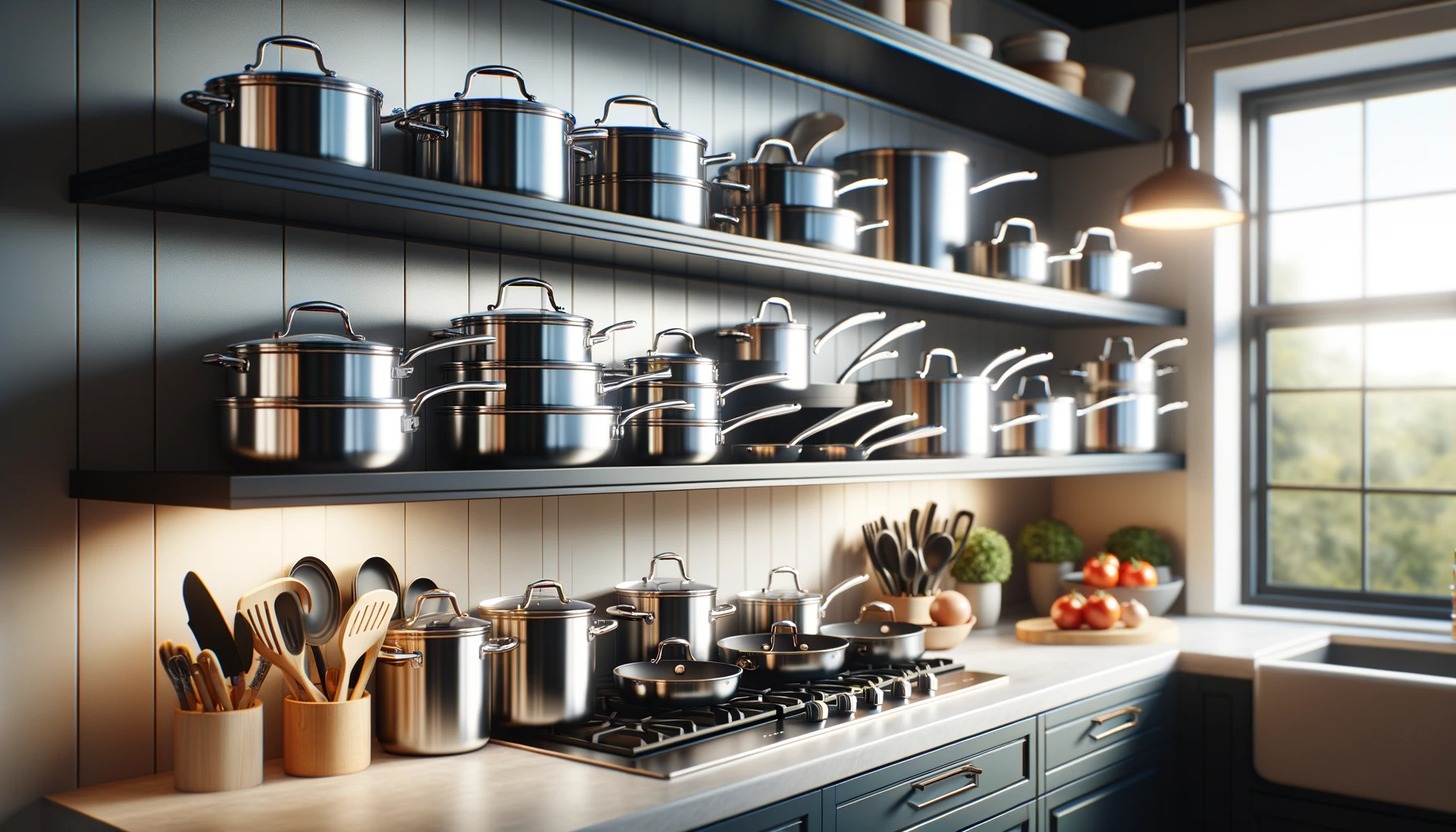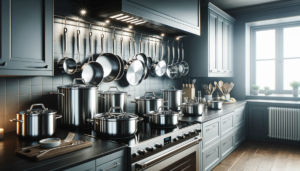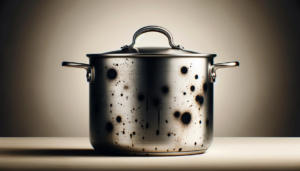Wondering if your reliable Cuisinart pans can safely handle oven use too or risk damage?
Assessing true oven suitability for Cuisinart cookware requires model-specific research alongside general material awareness.
Let’s explore manufacturer specs, common composition caveats, usage tips and oven-safe alternatives to determine if baking with your Cuisinart pans fits within advisable limits or if dedicated ovenware makes more sense.
Are Cuisinart Pans Oven-Safe?
The short answer is yes – many Cuisinart pans are indeed oven-safe to varying extents based on exact model specifications and material composition.
Stainless steel and anodized aluminum pans typically do well within home oven temperature ranges if avoiding sudden temperature changes during handling.
Non-stick finishes introduce greater heat limitations however.
Overall Cuisinart pans often prove oven-safe, but must be checked individually per guidelines below to confirm appropriate baking and broiling thresholds.
Now let’s explore specifics in more detail to equip your model research and inform safe usage procedures.
What Materials Are Cuisinart Pans Made Of?
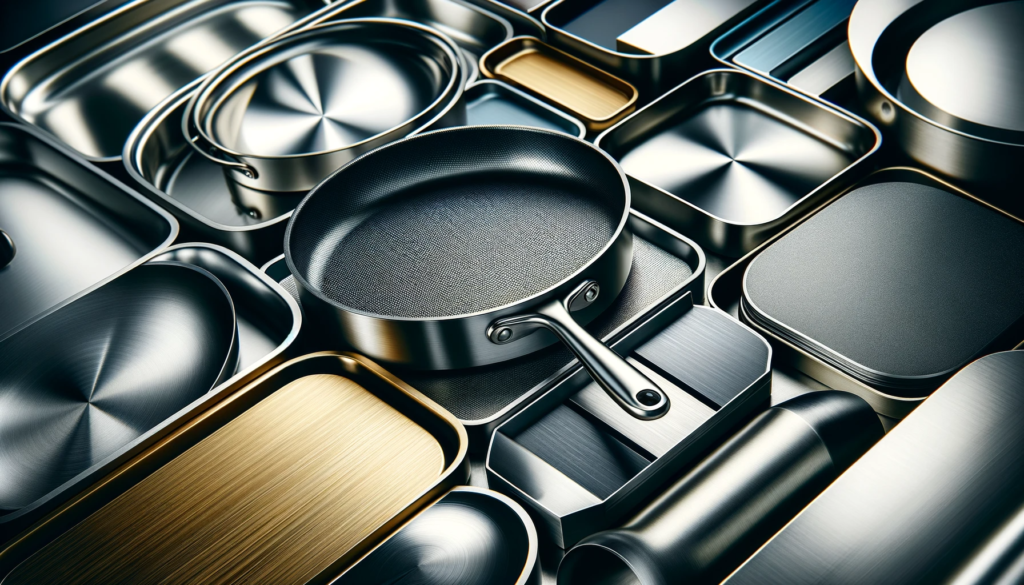
Cuisinart offers a wide range of cookware made from various materials such as stainless steel, aluminum, ceramic, non-stick coatings, and more.
The oven-safety of their pans depends largely on what they are made of.
Stainless steel, ceramic, and anodized aluminum can generally withstand high oven temperatures.
Materials like non-stick coatings often have lower maximum heat limits before the coating degrades.
It is important to understand what your specific Cuisinart pan is made of before using it in the oven.
This will determine the safe temperature range you should stay within.
Exceeding those oven-safe temperatures can damage the pan, affect non-stick performance, or even release toxic fumes in some cases.
Stainless Steel
Cuisinart stainless steel pans are a very popular option, prized for their durability and even heating.
The stainless steel itself can withstand very high oven temperatures, often over 500°F.
However, other parts of the pan may degrade at lower temperatures.
For example, stainless steel pans often have handles made of materials like plastic, rubber, or wood.
These handles can melt or burn if exposed to temperatures they are not rated for.
There may also be non-stick layers, ceramics coatings, or other materials that get applied as interior surfaces on some stainless pans.
So while the stainless steel exterior offers excellent high heat tolerance, you still need to consider the oven limits for the pan as a whole based on all its components.
Never assume a stainless steel exterior automatically means oven-safe at any temperature.
Check specs first.
Aluminum
Aluminum is an excellent heat conductor, making it a popular choice for cookware.
Plain aluminum can warp in high oven temperatures, so Cuisinart pans using aluminum often have other measures to enhance stability.
For example, some Cuisinart pans may sandwich an aluminum core between stainless steel exterior and interior layers.
This takes advantage of aluminum’s heat conduction while the stainless steel protects the shape at high temperatures.
Copper cores can also sometimes be used instead of aluminum in this “tri-ply” pan construction method.
Anodized aluminum is another approach.
An electrochemical process creates a protective oxidized layer on the aluminum exterior, enhancing corrosion resistance and stability for high heat tolerance.
However, any non-anodized parts or coatings may still have lower temp limits.
As with stainless, steps like handles, coatings, and inserts may not match the metal’s oven safety.
So while the aluminum itself can take plenty of heat if properly prepared, other factors may restrict the overall pan’s temp rating.
Non-Stick Coatings
Many Cuisinart pans feature non-stick surfaces like titanium or ceramics-reinforced coatings.
At high enough oven temperatures, these coatings can begin to degrade and release fumes.
Brands vary in their maximum rating, but often recommend staying below 500°F.
Exceeding the oven-safe rating can accelerate wear on these coatings, reducing non-stick performance over time.
Heating empty non-stick pans can also release harmful PFAs or PFOAs above a certain point as the coating breaks down.
Unless a Cuisinart non-stick pan clearly states higher oven limits, assume standard guidance to stay under 500°F oven temperatures, avoid preheating empty, and check regularly for deterioration during prolonged baking.
The metal beneath may tolerate higher temps, but the coating likely will not.
Checking Your Specific Cuisinart Pan

With such variation in materials and construction methods used across Cuisinart’s extensive cookware catalog, checking specs on your individual model is important for confirming oven safety.
Do not assume universal temperature thresholds.
Find your pan’s model number and reference Cuisinart’s documentation to know your specific limits.
Locating Your Model Number
Check the bottom or handles of your Cuisinart pan for a model or product number engraved into the metal.
It may be along the lines of something like “CPT-123” or “GreenGourmet CS-1234”.
There are sometimes product numbers printed on hang tags or packaging as well.
If you purchased your pan recently, check any included manuals, warranties, or paperwork for technical product identifiers.
If bought used or inherited without papers, examine the pan closely for any etched model detail or take clear photos showing all text or markings that could indicate the product number.
Without this crucial model info, it will be difficult to lookup specifications on oven safety and other performance criteria for your exact Cuisinart pan.
So locating these product identification codes should be your first step.
Researching Your Model Number
Once you have your Cuisinart pan’s model number, visit the official Cuisinart website and browse their cookware section, manuals, support pages, or contact customer service to identify documentation on your specific pan.
Search the model number listed to pull up any relevant specification sheets, owner’s manuals, warranties, use and care guides or other official references associated with that product.
Thoroughly read through these information sources for your particular pan to learn its oven safety ratings and care guidelines around high heat or baking use.
Key details to note are maximum oven temperatures listed, whether the pan can withstand broilers or not, any specifics around preheating duration recommendations, and whether certain components like handles may be removed before oven use.
Follow all manufacturer instructions for your model number to ensure proper use.
If adequate information on your pan is not available even after locating its model number and researching Cuisinart’s databases, contact their customer support with your product’s identification number in hand.
Their representatives can assist with pulling up specifications, answering safety questions, and providing usage recommendations on an individual model basis.
General Temperature Guidelines

While crucial to reference your Cuisinart pan’s exact documentation for oven limits, some broad temperature guidelines and heat resistance rules of thumb can also provide helpful context across common cookware materials.
Just remember your model’s specifics may differ.
Stainless Steel Oven Safety
As mentioned earlier, stainless steel itself can endure extremely high temperatures – far above home cooking demands.
But other potential parts of Cuisinart stainless pans impose lower limits.
Plastics, rubbers, and woods used in components like handles often cap out below 500°F, sometimes significantly lower towards 350-400° depending on quality.
Any coatings also introduce another variable restricting max heat.
So despite stainless steel’s strength, other factors commonly bring down the overall pan’s oven limits.
Assuming no extras like non-stick layers or special handles, most Cuisinart stainless steel pans without extras may safely withstand over 500°F oven temperatures.
Preheating is typically fine as stainless steel evenly distributes heat.
Just ensure potholders or mitts are used when removing hot pans from the oven to avoid burns.
Also let pans cool gradually – never expose extremely hot stainless steel to sudden temperature shocks like cold water or icy air.
This can damage the protective chromium layer leading to corrosion over time.
Aluminum & Copper Heat Tolerance
In their pure forms, aluminum and copper soften starting around 400-450°F oven temperatures.
But when reinforced with methods like tri-ply layering with steel or anodization, aluminum and copper cores inside Cuisinart pans can usually tolerate up to 500°F safely.
The key benefit of aluminum and copper is unmatched heating conductance.
This allows Cuisinart pans made with these metals to distribute heat remarkably evenly and responsively.
Just avoid exceeding maximum ratings to prevent any shaping issues.
Preheating pans before baking helps limit this risk by slowly bringing the metal up to temp.
As always, use reasonable potholders for hot pan handling while remembering to let cookware gradually normalize temperature before any rapid cooling to prevent warping.
Non-Stick Coating Limits
PTFE-based non-stick coatings from brands like Teflon begin off-gassing around 400°F and progressively degrade beyond 500°F oven temps.
Ceramic-infused coatings claim higher thresholds near 600°F but still run risks overheating empty or exceeding peak durations.
To play it safe with Cuisinart non-stick, keep oven usage under 500°F.
Avoid aggressive preheating or forgetting cookware while baking.
Never broil.
Monitor closely for anyvisual deterioration like color changes, bubbles, flakes or chipping clear coats during oven cooking.
Dial back temperatures at the first sign.
In addition to protecting the non-stick itself, lower oven ranges help limit fume exposure health threats.
Ventilate kitchens well during use.
Overall, non-stick coatings introduce the greatest temperature constraints for layered Cuisinart pans.
Tips For Using Cuisinart Pans In The Oven
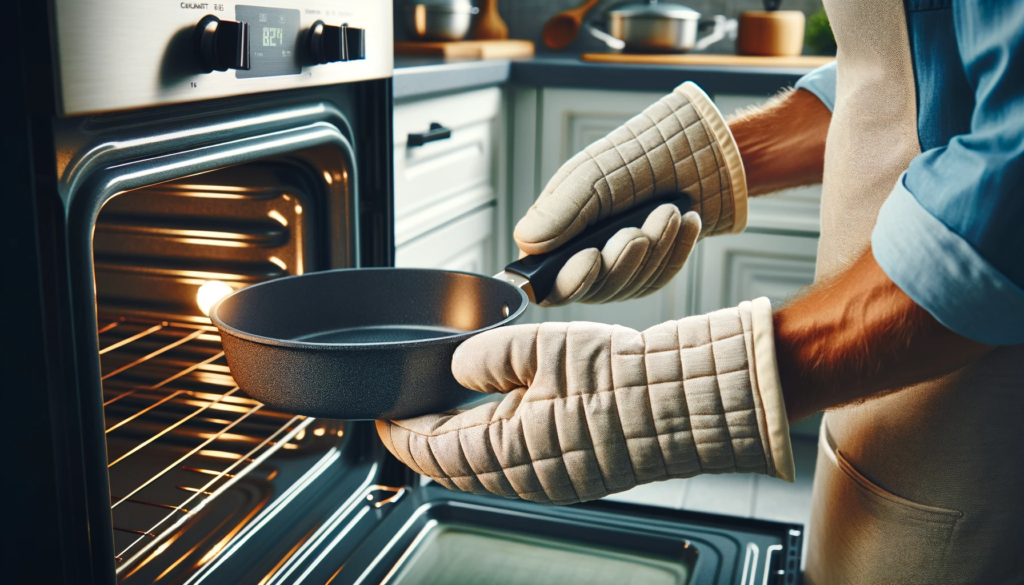
Here are some key tips for safely using your Cuisinart pans in the oven based on the material limitations and risks explored above:
Allow For Metal Expansion
When stainless steel, aluminum or copper pans from Cuisinart are heated to high oven temperatures, the metal naturally wants to expand some.
Allowing overhead room prevents spills.
Leaving space between pans prevents scraping or distortion issues too.
For baking dishes containing ingredients that may bubble over, consider rimmed sheet pans placed underneath to catch any spillover so your oven stays clean.
Tinfoil or parchment paper sheets inside can also make cleanup easier.
Finally, make sure your Cuisinart pans or baking dishes are centered with several inches clearance from oven walls.
Direct contact with hot metal racks or walls through expansion can damage exterior finishes leading to corrosion vulnerability.
Use Oven Mitts For Hot Handles
Even if the metal pan itself can take oven temperatures exceeding 500°F, plastic handles and knobs melt well below this threshold while metal handles quickly conduct extreme heat.
Remember to use quality oven mitts or potholders when inserting or removing Cuisinart pans and post-baking as well.
Never grab hot stainless steel handles barehanded.
Also give the top and bottom of the pan a visual check with mitts on before handling since direct contact with oven racks or walls may create intensely hotspots.
Getting a preliminary look before directly grabbing avoids painful surprises!
For high pan sides or cookware challenging to firmly grip with bulky oven mitts, consider using a secondary assisting tool like sturdy tongs able to clamp onto handles with better control and leverage.
Just make sure any supporting grip accessories are also thoroughly oven-safe rated.
Prevent Sudden Temperature Changes
Rapidly plunging an extremely hot Cuisinart pan into cold water or setting it on icy countertops risks damage through sudden contraction similar to how quick heating expands metals.
Allow your pan to gradually cool down closer to room temperature before any big temp variance.
Quick chilling through moisture contact can also damage protective exterior finishes by promoting material corrosion over repeated instances.
So after removing hot pans from the oven, set on a heat-safe trivet or unused burner well away from sinks or cold surfaces.
Give 10-20 minutes for the worst residual heat to normalize before cleaning.
Inspect For Damage After Use
After baking or broiling in the oven, carefully examine both the interior and exterior of your Cuisinart pans afterwards looking for any revealing signs of trouble.
Warped bases, color degradation of non-stick finishes, newly visible pitting, small bubble formations in coating layers or visible food residue burned into sides all indicate potential issues.
Catching problems early allows for closer review of what oven threshold or usage guidelines may need adjustment within the manufacturer specifications to prevent repeat overheating damage.
Finding defects right away also keeps small repairs or replacements more affordable before extensive issues arise costing large replacements.
Noticing deterioration changes through visual inspection after repeated oven use provides important feedback on where your particular Cuisinart pan’s personal limits truly lie in your real-world experience at home.
Adapt accordingly with extra caution going forward to maximize working lifespan through careful handling.
Alternatives If Your Pan Is Not Oven-Safe
What if you determine your specific Cuisinart pan should not be used in the oven based on its model number specs researched earlier? Or perhaps certain ingredients and conditions would simply exceed advisable limits regardless? There are still alternatives for finishing or heating meals with cookware not deemed fully oven safe:
Use Oven-Safe Bakeware Instead
Consider transferring seared, fried or otherwise stove top-prepared meals into compatible oven-safe baking vessels first.
High-walled casserole pans, gratin dishes, roasting pans and sturdy cake pans without non-stick coatings can all tolerate oven temps above 500°F easily.
Ceramic, tempered glass, enameled cast iron or metal bakeware without plastic handles or rubber feet make ideal transfer vessels for oven finishing or reheating use when your Cuisinart pan should not go directly in itself.
Just be sure to use potholders removing hot bakeware later!
Broil Foods Instead Of Baking
Broiling is quicker than baking by rapidly searing foods using overhead high heat blowing directly down.
So for simple finishing tasks like melting cheese over pasta, browning toppings or creating crispy crusts, consider switching to broil modes instead with close monitoring.
Most standard ovens offer upper heating elements perfect for direct exposure broiling.
Just avoid placing Cuisinart pans or ingredients higher than 8 inches or so from broil coils.
Watch foods carefully through the window to prevent scorching and pull items out once achieved to desired doneness level on top.
Finish Under The Broiler
Rather than baking entirely within the oven itself, another option is stove top pre-cooking meals first before transferring the pan directly under the boiler briefly just to finish with desirable browning and crisping as needed on top.
Use front burners to saute, sear, fry or boil foods in a Cuisinart pan as normal through mostly done.
Then pull the pan out with oven mitts on and carefully place right below the overhead broiler coils to blast with direct heat just long enough to achieve perfect texture or color on top as desired right at the end.
This allows the broiler’s intense heat to supplement stove top cooking without putting your Cuisinart pan inside the oven at all.
Just exercise caution when removing the extremely hot cookware later once broiler time finishes.
Consider tongs assisting grip as needed.
Conclusion
So are Cuisinart pans oven-safe? The answer depends on carefully checking your individual model’s specifications and abiding by any temperature or usage guidance listed.
While many Cuisinart pans can safely enter ovens, ensure handles, coatings and accessory parts fall within advisable limits as well.
Treat non-stick interiors with particular care to prevent degrading valuable resilience.
With sound research into your exact pan’s make-up alongside smart usage tactics like gloves and gradual heating/cooling, Cuisinart cookware should withstand occasional oven demands.
